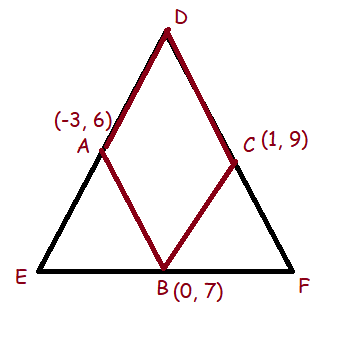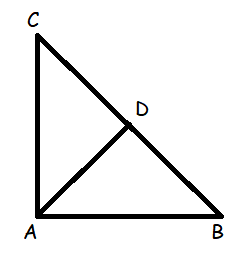PRACTICAL PROBLEMS USING MIDPOINT FORMULA
Question 1 :
The points A(−3, 6) , B(0, 7) and C(1, 9) are the mid-points of the sides DE, EF and FD of a triangle DEF. Show that the quadrilateral ABCD is a parallelogram
Solution :

In order to prove ABCD is a parallelogram, we have to find the point D.
= D (-3+1-0, 6+9-7)
= D (-2, 8)
In ABCD is a parallelogram, then midpoint of diagonals AC and BD will be equal.
Midpoint of AC = (-3 + 1)/2, (6 + 9)/2
= -2/2, 15/2
= (-1, 15/2)
Midpoint of BD
B(0, 7) and D(-2, 8)
= (0 - 2)/2, (7 + 8)/2
= -2/2, 15/2
= (-1, 15/2)
Hence ABCD is a parallelogram.
Question 2 :
A (−3, 2) , B (3, 2) and C (−3, −2) are the vertices of the right triangle, right angled at A. Show that the mid-point of the hypotenuse is equidistant from the vertices.
Solution :

Mid point of BC = (3 + (-3))/2, (2 + (-2))/2
= D (0, 0)
Distance between AD :
A(-3, 2) D(0, 0)
= √(x2 - x1)2 + (y2 - y1)2
= √(-3-0)2 + (2-0)2
= √9 + 4
= √13
C(-3, -2) D(0, 0)
= √(x2 - x1)2 + (y2 - y1)2
= √(-3-0)2 + (-2-0)2
= √9 + 4
= √13
B(3, 2) D(0, 0)
= √(x2 - x1)2 + (y2 - y1)2
= √(0-3)2 + (0-2)2
= √9 + 4
= √13
Hence the midpoint of the hypotenuse is equidistant from the vertices.
Kindly mail your feedback to v4formath@gmail.com
We always appreciate your feedback.
©All rights reserved. onlinemath4all.com
Recent Articles
-
Digital SAT Math Problems and Solutions (Part - 150)
Apr 25, 25 11:46 AM
Digital SAT Math Problems and Solutions (Part - 150) -
AP Calculus AB Problems with Solutions (Part - 19)
Apr 24, 25 11:10 PM
AP Calculus AB Problems with Solutions (Part - 19) -
AP Calculus AB Problems with Solutions (Part - 18)
Apr 24, 25 11:06 PM
AP Calculus AB Problems with Solutions (Part - 18)
